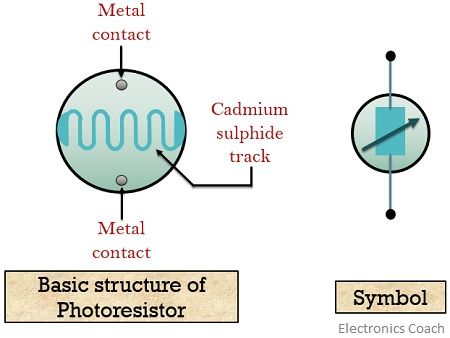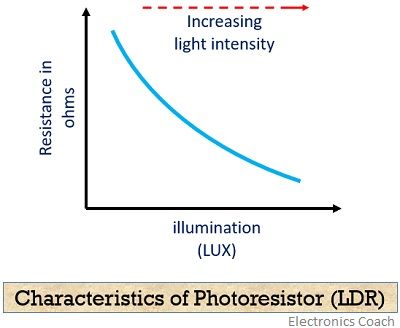Definition: Photoresistor is a type of device whose resistance changes with respect to the intensity of the incident radiation. It has a tremendous ability to change its resistance in exposure to light. LDR is an acronym for Light Dependent Resistor. It is a non-linear device.
The photoresistor is also termed as the light dependent resistor or photoconductor as it displays the property of photoconductivity.
What photoconductivity basically is?
It is the phenomenon which improves the conductivity of the material by absorbing electromagnetic radiation. The radiation can be a gamma, UV, IR radiation or a visible light.
Types of Photoresistor
It is of two types either intrinsic or extrinsic Light dependent resistor.
1. Intrinsic photoresistor
This category of LDR is composed of undoped semiconductor material i.e., these are made from pure semiconductor material either silicon or germanium. Sufficient amount of light energy is needed to excite the electron from the valence band to conduction band.
2. Extrinsic photoresistor
This type of LDR is made up of doped semiconductor material. The doping constitutes a new energy level above the valence band. Thereby reducing the light energy required to excite the electron.
Basic structure and construction of Photoresistor
The photoresistor is composed of light-sensitive semiconductor material. Usually, it is made up of cadmium sulphide having negligible free electrons in the absence of any incident radiation.
In the absence of light, LDR possesses very high resistance of about several mega ohms. However, in the presence of light, it exhibits low resistance property, having the resistance of about a few hundred ohms.
The figure below shows the basic construction and symbol of photoresistor:

The device consists of a snake-like or zigzag pattern track which is made up of cadmium sulphide. The snake-like arrangement is done in order to get the expected power rating and resistance.
This track separates a pair of metal contact. The whole structure is placed in a plastic case so as to have direct exposure to the incident radiation. As it is required to change the resistance by the action of light in LDR, so the resistance of the metal contacts must be low.
Working of Photoresistor
As we are now familiar with the fact that LDR or Photoresistor are photoconductive materials.
By the absorption of light rays, the valence band electrons get excited to the conduction band. It is to be noted here that proper light energy is required by the electron to excite into the conduction band.
Thus, higher the light energy, higher will be the presence of charge carriers resulting in greater conductivity.
Let us now see the approximate relationship between resistance and illumination, which is given as
 Here, R denotes the resistance in ohm
Here, R denotes the resistance in ohm
E denotes the illumination and
A and α are constant
The manufacturing procedure and Cadmium sulphide decide the value of constant α.
LDR Characteristics
The figure below shows the characteristic curve of resistance versus light intensity

Here, we can see in the figure above, when the intensity of light is less i.e., in the darker region, the resistance is higher resulting in less conductive nature of the material.
As the intensity is further increased, it causes the resistance to decrease. Thus, enhancing conductivity. Hence, it can be said that resistance falls with rise in the intensity of light.
In the introduction of Photoresistor, we have already mentioned that it is a non-linear device. This is so because the wavelength of the light that falls on its surface varies the sensitivity of the device. As there exist some photoresistors that do not respond to a certain range of light signal wavelength.
The variation in resistance is done in about 8 to 12 ms after the incidence of radiation. However, greater than 1 s is needed for the resistance to increase to a higher value in case of less intensity of light.
In other words, we can say when the device is exposed to a dark region from certain illumination level, it does not increase rapidly. This is known as Recovery rate of resistance.
Advantages of Photoresistor
- LDR provides good voltage and power handling capability.
- It is a low-cost device and is readily available.
Disadvantage of Photoresistor
- The variation of resistance is somewhat slow to rapid light action.
Applications of Photoresistor
- LDR finds its application in light and dark activated alarms and switches.
- These are also used in controlling the street lights automatically.
- LDR is also used in light intensity meter and smoke alarms etc.
It is noteworthy here that Photodiode or Phototransistor are more sensitive to light as compared to the Light dependent resistor. This is so because photodiode and phototransistor are basically true semiconductor material having PN junction whereas PN junction is absent in LDR as it is a passive component.
Leave a Reply